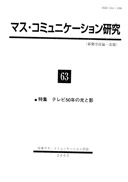Volume 63
Displaying 1-22 of 22 articles from this issue
- |<
- <
- 1
- >
- >|
-
Article type: Article
2003Volume 63 Pages 2-3
Published: July 31, 2003
Released on J-STAGE: October 06, 2017
Download PDF (126K) -
Article type: Article
2003Volume 63 Pages 4-21
Published: July 31, 2003
Released on J-STAGE: October 06, 2017
Download PDF (1157K) -
Article type: Article
2003Volume 63 Pages 22-39
Published: July 31, 2003
Released on J-STAGE: October 06, 2017
Download PDF (1391K) -
Article type: Article
2003Volume 63 Pages 40-53
Published: July 31, 2003
Released on J-STAGE: October 06, 2017
Download PDF (1109K) -
Article type: Article
2003Volume 63 Pages 54-71
Published: July 31, 2003
Released on J-STAGE: October 06, 2017
Download PDF (1265K) -
Article type: Article
2003Volume 63 Pages 72-97
Published: July 31, 2003
Released on J-STAGE: October 06, 2017
Download PDF (2156K)
-
Article type: Article
2003Volume 63 Pages 98-111
Published: July 31, 2003
Released on J-STAGE: October 06, 2017
Download PDF (1121K) -
Article type: Article
2003Volume 63 Pages 112-129
Published: July 31, 2003
Released on J-STAGE: October 06, 2017
Download PDF (1330K) -
Article type: Article
2003Volume 63 Pages 130-143
Published: July 31, 2003
Released on J-STAGE: October 06, 2017
Download PDF (1118K) -
Article type: Article
2003Volume 63 Pages 144-161
Published: July 31, 2003
Released on J-STAGE: October 06, 2017
Download PDF (1539K)
-
Article type: Article
2003Volume 63 Pages 162-163
Published: July 31, 2003
Released on J-STAGE: October 06, 2017
Download PDF (208K) -
Article type: Article
2003Volume 63 Pages 163-164
Published: July 31, 2003
Released on J-STAGE: October 06, 2017
Download PDF (214K) -
Article type: Article
2003Volume 63 Pages 164-166
Published: July 31, 2003
Released on J-STAGE: October 06, 2017
Download PDF (299K) -
Article type: Article
2003Volume 63 Pages 166-167
Published: July 31, 2003
Released on J-STAGE: October 06, 2017
Download PDF (211K) -
Article type: Article
2003Volume 63 Pages 168-169
Published: July 31, 2003
Released on J-STAGE: October 06, 2017
Download PDF (190K) -
Article type: Article
2003Volume 63 Pages 169-170
Published: July 31, 2003
Released on J-STAGE: October 06, 2017
Download PDF (199K) -
Article type: Article
2003Volume 63 Pages 170-172
Published: July 31, 2003
Released on J-STAGE: October 06, 2017
Download PDF (290K) -
Article type: Article
2003Volume 63 Pages 172-174
Published: July 31, 2003
Released on J-STAGE: October 06, 2017
Download PDF (292K) -
Article type: Article
2003Volume 63 Pages 174-175
Published: July 31, 2003
Released on J-STAGE: October 06, 2017
Download PDF (227K)
-
Article type: Article
2003Volume 63 Pages 176-177
Published: July 31, 2003
Released on J-STAGE: October 06, 2017
Download PDF (207K) -
Article type: Article
2003Volume 63 Pages 177-178
Published: July 31, 2003
Released on J-STAGE: October 06, 2017
Download PDF (187K)
-
Article type: Appendix
2003Volume 63 Pages 200-179
Published: July 31, 2003
Released on J-STAGE: October 06, 2017
Download PDF (972K)
- |<
- <
- 1
- >
- >|
